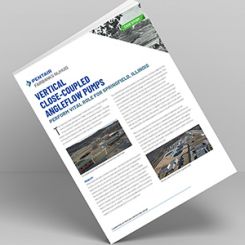
Mike Dillon, now retired as president of SEEPEX, came into the pumps industry in a roundabout way—one that started from the ground up.
After 31 years at SEEPEX, Dillon said he looks back now and describes his career as having very few dull moments.
“I guess I just groomed myself for the job at SEEPEX, I just didn’t know it. I loved it. It was interesting and challenging. I could use all my talents and experience,” he said.
Dillon started working at Robbins and Myers when he turned 18 — as his grandfather was an inspector in the motor group and got him a summer job. This turned into a full-time position in 1973 working for the corporate marketing department, using his undergraduate degree in public relations and advertising and master’s degree in organizational communication.
“I am a genuine Mad Man,” Dillon said. “I started my professional career in advertising. I actually had an ad agency in Athens [Ohio] when I was in school. There were three of us and we had a bank, a hospital and a few other accounts. But I actually started school in pre-med. So, I have all the basic chemistry, calculus, botany, zoology and physics classes. At OU’s [Ohio University] school of Journalism, you had to have a second major. Mine was general science. That was convenient when it became apparent that I would not finish the pre-med program before my four-year draft deferment expired.”
With family who are mostly factory workers, Dillon said he learned about the pumps industry from the inside. When he was younger, he took summer jobs making electric motors, working in a foundry, on a truck assembly line and in a machine shop. Because of this experience, and then his training as a writer, he said he had no trouble understanding how pumps, motors and gear reducers worked, which helped him be accepted at Robbins & Myers. He also helped the engineering manager there get a few articles published.
“So, he became my forever friend and a mentor,” Dillon said.
“After two years, the pump division, then Moyno, needed a person full time. I stayed with Moyno for 15 years with positions in marketing, sales, new business development, vice president and general manager of their Canadian operation and vice president of marketing,” Dillon said.
He was told the only way he could progress in his career was to have a better understanding of financial decisions. So, he enrolled in an evening MBA program, but was sidetracked for three years when he took an offer to be a direct salesman for Moyno in Boston.
“I often tell people that I learned more in those three years than I learned in my eight years at a university. In those days, the salesman had to do it all: drum up customers without an inside engineer, do all your calculations (on paper or with a slide rule—this was before handheld calculators existed), write up your offers, enter orders—everything. Spare parts were handled through an 800 number at the factory (thank goodness). A position became available for a new business analyst back at the factory. R&M generally filled those jobs with new, Ivy League MBA grads. But due to my experience with the company, I got the job and finished my MBA at night, concentrating on accounting and finance.”
After finishing the coursework in March 1984, Dillon became vice president and general manager of R&M Canada. NAFTA was passed in 1987 and R&M closed the plant in Canada, and he returned as vice president of marketing, but he was really running all the foreign operations. He spent time traveling to Europe, Asia and Australia.
“I traveled a lot and had a young family and I wanted out. A good friend in Canada told me that SEEPEX was looking for someone to lead their entry into the U.S. market. I knew SEEPEX and the quality of their products from my time in Canada. In fact, I was very interested in the SEEPEX line of small metering and dosing pumps,” Dillon said. “I had been trying for a long time to get the R&M pump and motor divisions to work on a joint product. I had worked on getting UL approval for the R&M DC motor line and knew the pump products, so it seemed like a natural marriage.
“It was really like trying to get a Hatfield to go on a date with a McCoy. Two weeks after I was told SEEPEX was looking, I was gone.”
Dillon said he had two formal training sessions and, thankfully, his previous experience came in handy.
“With all the work I did on advertising, brochures and revising all the pump sizing and selection programs and the introduction of three new product lines, as well as in-depth analysis of competitors’ products, I had the opportunity and desire to figure it out,” he said.
“I guess I just groomed myself for the job at SEEPEX, I just didn’t know it.”
10 Tips for Success from SEEPEX former president Mike Dillon
Advice to industry newcomers
“Just do what you enjoy. If you’re good at it, opportunities will find you. Don’t try to do something you hate. You won’t be able to put the time into it to be good at it, and if you’re not good at it, you won’t go anywhere. I know that’s the speech made by all the winners at the Oscars and the Grammys but it probably is true universally.
When faced with inter-office politics
“Like many people, I got caught up in some ‘political’ situations and had to side-step at least three times. Luckily, I always seemed to have made a friend that believed in my capabilities and dedication and they helped me find a safe place to land.”
3 ingredients that help a company find success
“Don’t make the same mistakes as others who have failed in the past.” “Tactics and implementation are probably more important than strategy.” “Always, always, always do what is right for the long term.”
3 ingredients that help employees find success
“If your superior wants you to do something, don’t complain: just do it.” “Complete objectives early so everyone can see the results of your good work.” “Don’t let anyone be an excuse for you not completing your objectives. Go over, around or through them. Make a difference and get things done.”
How to establish a good relationship with new employees
"Onboarding is critical, and all internal contacts need to part of the process.” “Try to get every employee to visit customers and have customers meet employees. Shorten the distance between the producer and the user.” “Formal training is critical. SEEPEX has a whole battery of lessons on the SEEPEX “Campus” electronic website. But have the technical and systems materials readily available offline, so people can get to it easily.” “Use mentors as much as possible.”
What to look for in potential newcomers to your company
“You can’t make a silk purse out of a sow’s ear. Make sure the hire has the capability to understand the concepts required for them to do their job.” “If they can’t explain NPSH [net positive suction head], don’t hire them as an engineer or a salesman.” “Make sure they can put forth the effort to succeed.” “Don’t overlook errors on resumes, the importance of being on time, careless appearance or sloppy language. If they didn’t learn the three “R’s” in grade school, they will not change for you.” “Most people fail because they were bad hires in the beginning and someone was willing to settle, because it was too difficult to find the right person. People get hired for their capabilities and fired for their personalities.”
On retaining good employees
“The company has to be competitive with wages and benefits and exceptional performance review or feedback systems. It is critical to be consistently honest and forthright.”
What are some words you live by?
“Like they say, it’s not how many times you get knocked down, it’s how many times you get back up. It’s not always easy to get back up, and sometimes it takes a while, and it’s never easy.”
What books do you recommend to colleagues?
“I like to read books by Ron Chernow, David McCollough and Walter Isaacson.”
On how the pumps industry could improve
“It is sad to see the huge conglomerates controlling the industry. In the process of culling less profitable operations or products, masses of customers are being left behind, especially in the U.S. That just drives more manufacturing offshore. Not just pump manufacturing, but any manufacturer that uses pumps and needs a personalized solution. All manufacturers try to differentiate. Even chemical manufacturers and paper companies. If a company wants to differentiate, they will need a unique and customer solution. It is a mistake to look at pumps as a commodity. It is bad for the pump industry and American industry as a whole.”

